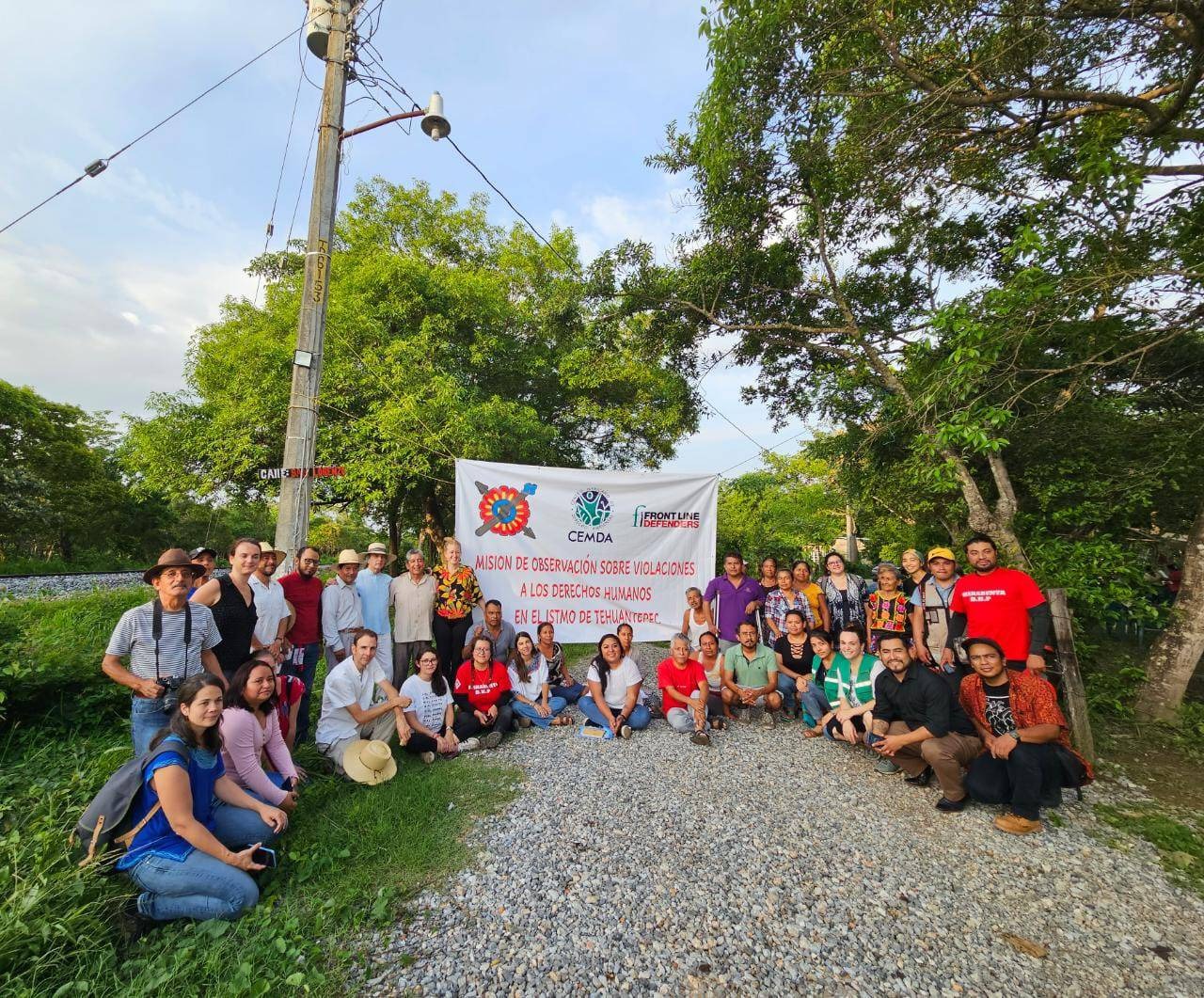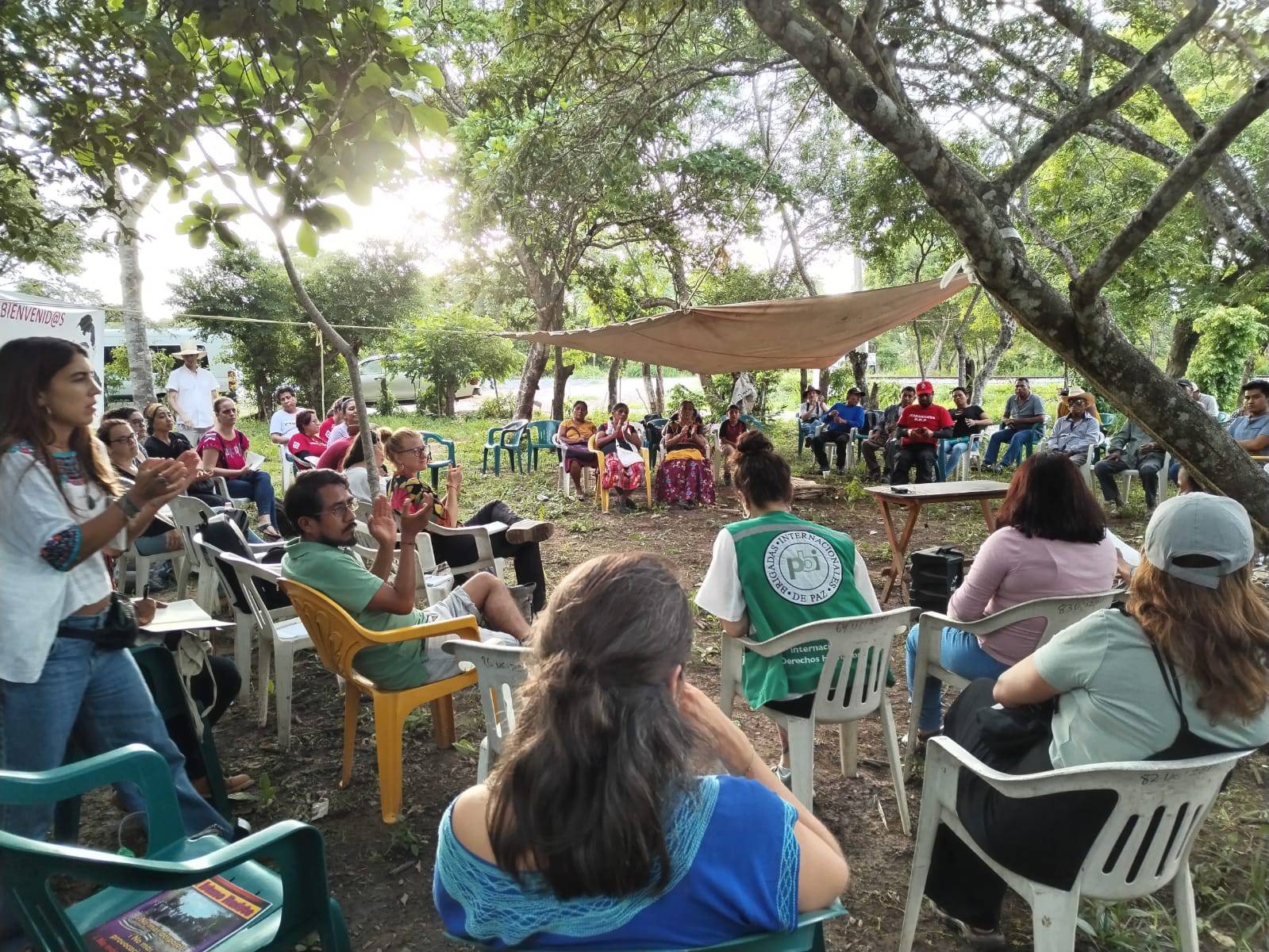The midday sun burns relentlessly on the small patio of Santa María Mixtequilla (SMM) in the Mexican state of Oaxaca, where 50 people have gathered. Some of the women try to keep cool with paper fans, while the men wear large sombreros to alleviate the heat of Istmo. An elderly man stands up and speaks decisively, while the crowd shows their support for his words with subtle movements of their heads: “they want to pay us for a metre of land with the value of a kilo of tortillas”. One of the industrial development hubs, a wind farm, stretches across 502 hectares of the municipality of SMM and was approved in 2021 through what the community terms a “simulated consultation”, given that not everyone was informed or included in the decision-making. The man talks about how the project has generated a profound division in the community between those who have already sold their land and those who consider the payment (of 1.40 EUR per m2) too low and demand that their history and heritage – as indigenous community - be recognised in the territory, as well as the environmental consequences for future generations. According to local organizations, the socio-environmental effects of the project have not been made clear and nor have they been properly analysed in their entirety by a national mechanism for evaluating the environmental impact of development initiatives. Moreover, no plan for civil protection has been presented. The community demands a second consultation in which the entire community can participate, and which will include clear and verified data about the advantages and disadvantages of the project; thus requesting that their right to a consultation and free, prior and informed consent (FPIC) is respected, as established by national and international standards[1].
 The violations suffered by the community of the municipality of SMM are only some of the testimonies collected by the Observation Mission that took place in the region of the Isthmus of Tehuantepec between the 25-27th July 2023, visiting 4 indigenous communities affected by the Interoceanic Corridor[2] and its industrial development hubs[3]: Mogoñé Viejo, Santa María Mixtequilla, Santa Cruz Tagolaba, and Puente Madera. The Mission - convened by the Union of Indigenous Communities of the Northern Zone of Istmo (UCIZONI)[4], the Mexican Centre for Environmental Rights (CEMDA)[5], and Front Line Defenders (FLD) – involved the participation of 19 national and international civil society organisations, including PBI, and 8 media representatives, with the aim of documenting and raising awareness of the human rights violations caused by the Interoceanic Corridor.
The violations suffered by the community of the municipality of SMM are only some of the testimonies collected by the Observation Mission that took place in the region of the Isthmus of Tehuantepec between the 25-27th July 2023, visiting 4 indigenous communities affected by the Interoceanic Corridor[2] and its industrial development hubs[3]: Mogoñé Viejo, Santa María Mixtequilla, Santa Cruz Tagolaba, and Puente Madera. The Mission - convened by the Union of Indigenous Communities of the Northern Zone of Istmo (UCIZONI)[4], the Mexican Centre for Environmental Rights (CEMDA)[5], and Front Line Defenders (FLD) – involved the participation of 19 national and international civil society organisations, including PBI, and 8 media representatives, with the aim of documenting and raising awareness of the human rights violations caused by the Interoceanic Corridor.
The Isthmus of Tehuantepec is the Mexico´s narrowest zone between the two oceans (Pacific and Atlantic), along the Gulf of Mexico. As well as the state of Oaxaca, the Isthmus includes the states of Veracruz, Chiapas, and Tabasco. The region is characterised by a high percentages of indigenous population (mainly of Zapotec and Huave descent) and a long history of resistence. There has been a rapidly increasing number of controversial industrial initiatives in the area, due to the wealth of its natural resources and its biodiversity, which now form part of broader development plans such as wind farms, given the excellent wind conditions of the region, and the Interoceanic Corridor.
The Corridor intends to link the harbours of Coatzacoalcos (Veracruz) and Salina Cruz (Oaxaca), impacting at least 79 municipalities (33 in Veracruz and 46 in Oaxaca), to eventually connect with another large-scale investment project, the Mayan Train. The objective is to encourage national and international trade and for businesses to relocate there, but with this comes the high risk of damaging the land and the customs of the peoples who inhabit the region. The project commenced in September 2019 and since then, multiple events have occurred to the detriment of communities in disagreement with its implementation and who have been directly and indirectly subjected to different forms of aggressions. Until now, incidents of threats, harassment, criminalisation, injuries, and murders have been recorded. In the context of macro-crime which characterises many parts of Mexico, the interests of the private sector, organised crime networks and public administrations coincide in relation to the Interoceanic Corridor.
As participants of the Observation Mission, patterns in the violations suffered by the communities and their members were identified. The four communities mentioned above reported that the consultations held had been performative at best, with whole sections of the communities excluded due to selective invitations and fraudulent participation (falsified signatures, even of people who are long dead). Furthermore, the assemblies did not properly inform the communities of the implications of the projects, since the state and federal government only highlight the benefits the projects would bring, such as the construction of schools, hospitals, access to drinking water, and other programmes that show no sign of starting.
In the communities, where conflict and divisions have arisen over the projects, the activists that have spoken out against them and those who opose the dispossession of their land, have been victims of threats, physical aggression, harassment, eviction notices, extortion, arbitrary detention, criminalisation, the militarisation of the territory, and in the gravest of cases, assassinations[6].
There are currently 11 investigations open against community members of Mogoñé Viejo for attacking the general communication route, while 6 others (4 women and 2 men) were arbitrarily detained by the State Police, the National Guard and the Marines, after organising a barricade in April 2023 in the Campamiento Tierra y Libertad against the Corridor. In the community of Santa Cruz Tagolaba, 7 people are involved in judicial proceedings, highlighting the stigmitisation and criminalisation of their struggles to defend the land and territory. In Puente Madera, 17 community members have an arrest warrant against them. The same community managed to bring a lawsuit against the San Blas Atempa Wellbeing industrial development hub in June 2023[7], which prevented the construction of an industrial park in an area of collective use known to the community as “El Pitayal”, which is one of the 10 hubs scheduled to form part of the Interoceanic Corridor.
 As stated in the report Informe sobre la situación de las personas y comunidades defensoras de los derechos humanos ambientales en México[8] published by the CEMDA, which has been published annually since 2012, between October 2021 and July 2023, 31 individual and collective attacks have been registered against human rights defenders in the context of the Interoceanic Corridor, primarily in Oaxaca and Veracruz. For the most part, the incidents have been committed against people who belong to indigenous communities. The databases linked to the Interoceanic Corridor project indicate at least: 21 cases of intimidation, harassment and threats against human rights defenders themselves, or their families; 11 cases of physical and psychological violence including forced eviction; 3 cases of homicide between Octuber 2022 and July 2023; 2 cases of defamation by widespread media outlets; and 43 cases of criminal charges against local authorities and human rights defenders in the communities of San Juan Guichicovi, Mogoñé Viejo, Mogoñé Estación, Paso Real, Estación Sarabia, Tagolaba, and Puente Madera.
As stated in the report Informe sobre la situación de las personas y comunidades defensoras de los derechos humanos ambientales en México[8] published by the CEMDA, which has been published annually since 2012, between October 2021 and July 2023, 31 individual and collective attacks have been registered against human rights defenders in the context of the Interoceanic Corridor, primarily in Oaxaca and Veracruz. For the most part, the incidents have been committed against people who belong to indigenous communities. The databases linked to the Interoceanic Corridor project indicate at least: 21 cases of intimidation, harassment and threats against human rights defenders themselves, or their families; 11 cases of physical and psychological violence including forced eviction; 3 cases of homicide between Octuber 2022 and July 2023; 2 cases of defamation by widespread media outlets; and 43 cases of criminal charges against local authorities and human rights defenders in the communities of San Juan Guichicovi, Mogoñé Viejo, Mogoñé Estación, Paso Real, Estación Sarabia, Tagolaba, and Puente Madera.
On 27th July, the Observation Mission held a press conference in Juchitán (Oaxaca)[9], where the national and international organisations expressed their concerns about the violations occurring in the context of the Interoceanic Corridor and the industrial development hubs, and the affected communities shared their experiences. The Mission also put out a call to the relevant authorities, highlighting the following points:
- To recognise and respect the right to self-determination, to autonomy, to land, to participation, to free, informed and prior consent, and to the life of indigenous people, in accordance with the highest standard of protection.
- To guarantee the right of access to justice and to prevent all forms of threats and aggression against indigenous people, human rights defenders and environmental activists.
- To take the necessary steps to guarantee an environment in which defenders can carry out their work safely, in the framework of Article 9 of the Regional Agreement on Access to Information, Public Participation and Justice in Environmental Matters in Latin America and the Caribbean[10].
- To provide indigenous communities with necessary information about the projects and all its components, such as the gas pipeline and the development hubs, in a way that is complete, sufficient and culturally appropriate, to enable them to exercise their right to self-determination.
The press conference closed with a specific question for the communities: can things go back to how they were before? The human rights defender, and member of UCIZONI, Juana Ramírez answered:
“Our colleagues have been murdered, who is going to return those lives?
Who will bring us justice?
Who is going to return the natural environment to how we had it before?
Nothing is going to be how it was before, because the rivers are polluted, the flora and fauna are destroyed, and nobody is going to return those, nobody is going to offer us compensation. No amount of money can pay for those damages, because they are damages which will last forever and which will continue to affect the future generations who follow us. In this fight we are defending life, even of the next generations.
It is important that the state and federal governments open a dialogue that reviews in minute detail the negative environmental, social and cultural impacts that these types of projects have.
There can be no development while there is poverty and marginalisation in our communities, nor a lack of health and education infrastructure, and there can no be development while our rights are being violated”.
The situation in Isthmus of Tehuantepec, and the fate of the communities that inhabit it, will continue to be worrying. As a result, PBI amplifies the voice of the human rights defenders in the region who, in spite of the violence they face, are fighting tirelessly for the rights of the individual and the collective rights of their communities, indigenous populations and their customs.
[2] Corredor Interoceánico del Istmo de Tehuantepec (CIIT) in Spanish.
[3] The industrial development hubs (Polos de Desarrollo in Spanish) are small geographical areas in which industrial activities are promoted in order to stimulate local development.
[4] Unión de Comunidades Indígenas de la Zona Norte del Istmo.
[5] Centro Mexicano de Derecho Ambiental.
[6]https://www.infobae.com/america/mexico/2022/10/29/asesinaron-a-jesus-manuel-garcia-activista-ambiental-opositor-al-corredor-interoceanico-del-istmo/
[10]Escazú Agreement: https://www.cepal.org/en/escazuagreement
